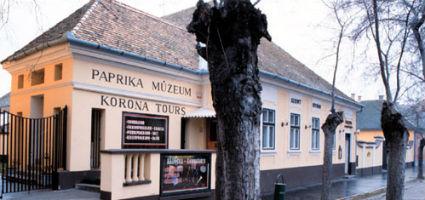2024. April 20. Saturday
Hungarian Red Pepper Museum - Kalocsa
 |
Address: 6300, Kalocsa Szent István király út 6.
Phone number: (78) 461-860, (30) 575-0716
E-mail: kincstar@asztrik.hu
Opening hours: 01.04-31.10.: Tue-Sun 9-17
|
The museum has been in operation at its present place (6 Szent István út) since 1991. Prior to that documents and tools connected to the history of red peper (paprika) planting were kept in the Mill building of the Piac square.
The museum presents the history of red pepper ever since its crossing through the ocean. Although the plant entered our country through Turkish mediation, it became the most tipically Hungarian spice. In Napoleon's time black pepper was substituted by red pepper which turned out to be a good medicine for certain deseases, too.
The most famous paprika producing areas in Hungary are the vicinities of Kalocsa and Szeged. Here the sun shines more than 2000 hours/year, which is the highest in Hungary.
Paprikas are to planted around April or May. Harvest is between the end August and about the first frost, the middle of August. Planting works are done by machines, but harvesting is still done by hand, for paprikas do not turn into red at the same time.
In the region of Kalocsa "red gold" is harvested in September from lands expounding up to 6000 hectares. After the harvest women used to string paprikas and hang them up to dry, but today it is also done by machine power. Drying process is followed by drinding. First the paprikas are wiped about, their cores are removed, then they are ground together with their seeds, because the seeds are very rich in oil that helps the paprica preserve its nice colour. In the museum there are machines and tools used for the processing exhibited.
The names of Jenő Horváth and Ernő Obermayer are worthy of mentioning. They improved the sweet pepper in the Pepper Research Institute of Kalocsa. (Earlier papricas were hot, having to be washed as long as their strengh diminished.)
The museum presents the history of red pepper ever since its crossing through the ocean. Although the plant entered our country through Turkish mediation, it became the most tipically Hungarian spice. In Napoleon's time black pepper was substituted by red pepper which turned out to be a good medicine for certain deseases, too.
The most famous paprika producing areas in Hungary are the vicinities of Kalocsa and Szeged. Here the sun shines more than 2000 hours/year, which is the highest in Hungary.
Paprikas are to planted around April or May. Harvest is between the end August and about the first frost, the middle of August. Planting works are done by machines, but harvesting is still done by hand, for paprikas do not turn into red at the same time.
In the region of Kalocsa "red gold" is harvested in September from lands expounding up to 6000 hectares. After the harvest women used to string paprikas and hang them up to dry, but today it is also done by machine power. Drying process is followed by drinding. First the paprikas are wiped about, their cores are removed, then they are ground together with their seeds, because the seeds are very rich in oil that helps the paprica preserve its nice colour. In the museum there are machines and tools used for the processing exhibited.
The names of Jenő Horváth and Ernő Obermayer are worthy of mentioning. They improved the sweet pepper in the Pepper Research Institute of Kalocsa. (Earlier papricas were hot, having to be washed as long as their strengh diminished.)
|
Permanent exhibitions
|
|